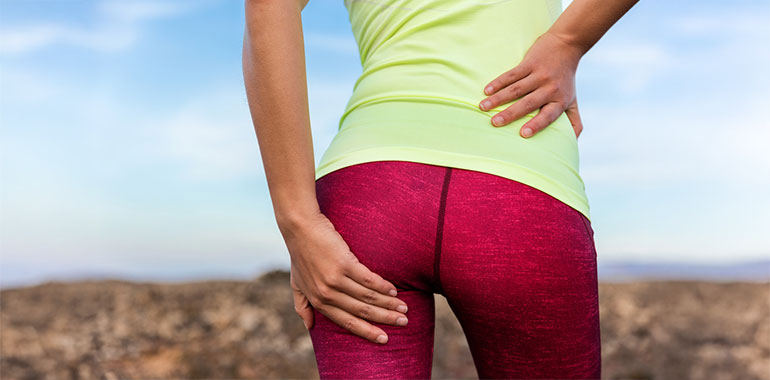
The Glute Connection: How Strong Glutes Can Help Alleviate Back Pain
Back pain is one of the most common reasons people seek medical attention or miss work. It is the biggest reason why patients come for skilled physical therapy because it impacts their life on such a massive level. It can be a chronic burden or a sudden disruption, affecting your ability to move freely and comfortably. At our pelvic floor physical therapy office, we often see patients who are surprised to learn that their back pain isn’t just about their spine – it’s also deeply connected to the strength and function of their gluteal muscles.
Understanding the Pelvic-Lumbar Connection
The pelvis acts as the foundation of your spine. It supports your trunk and connects your upper and lower body. The muscles of the pelvic region, particularly the gluteals (gluteus maximus, medius, and minimus), play a critical role in stabilizing this area. When these muscles are weak or underactive, the stability of the pelvis is compromised, placing added stress on the lumbar spine (lower back).
This is especially relevant in pelvic floor physical therapy, as the pelvic floor muscles also contribute to this stabilization system. When the glutes are weak, the body compensates in less efficient ways, leading to imbalances and overuse of other muscles like the lower back extensors, pelvic floor and hip flexors. This creates a cycle of dysfunction that often results in chronic or recurring back pain.
Why Glutes Matter More Than You Think
The gluteal muscles are among the most powerful muscles in the body. They are responsible for a wide range of movements, including:
Beyond these basic actions, the glutes play a foundational role in pelvic stability. They have an important job and when functioning correctly, they:
Signs Your Glutes May Be Weak
It’s not uncommon to have weakness in your gluteal muscles that eventually lead to pain and difficulty doing all the activities that you love. You might be dealing with gluteal weakness if you experience any of the following:
In our clinic, we often observe a phenomenon called "gluteal amnesia," where the brain has trouble activating the glutes properly due to prolonged sitting, injury, surgery or poor movement habits. Re-establishing this mind-muscle connection is a crucial first step in both relieving back pain and preventing its recurrence.
We start with the basics to help you activate your gluteals, but we are not shy to bump up the challenge so that you can really feel these muscles work. Sometimes the body needs an increase in challenge to help your mind make the connection with the gluteals. Then you will see real muscle changes and strength gains that will correspondingly reduce your back pain, giving you more support around your spine.
Not all gluteal exercises are created equal – so many of our patients have done the standard strengthening exercises that were given to them in the past or found online. We take the effective and creative route to ensure that you feel the muscle contraction in your gluteals when performing your exercises. Checking in for progress and making tweaks along the way so that you have real changes in your strength.
The Glute-Pelvic Floor Team
The pelvic floor and gluteal muscles function together as part of a larger system called the "core canister," which includes the diaphragm, deep abdominal muscles, and spinal stabilizers. When one component is weak or dysfunctional, the entire system is affected.
For example, if the glutes aren't doing their job stabilizing the pelvis while walking, the pelvic floor may become overactive or strained as it tries to compensate. This can lead to symptoms such as:
Strengthening the glutes can reduce the burden on the pelvic floor, promote better coordination, and help restore balance throughout the entire core. In actuality, we need balance of all these muscles around the pelvis (abdominals, diaphragm, gluteals, pelvic floor) to reduce and prevent back pain. If one muscle group is lagging in its job, then pain and dysfunction will start to emerge. It highlights the importance of balance around the pelvis in all muscle groups.
Key Glute-Strengthening Exercises
At our office, we guide patients through individualized exercise plans. Form is essential and if you don’t feel these exercises in the gluteals, stop and consult a physical therapist for guidance.
We always prescribe movements that are best for YOUR body, but here are some commonly prescribed glute-strengthening exercises that support both the pelvis and the spine:
1. Glute Bridges
2. Locked Clamshells
3. Quadruped Fire Hydrants
4. Quadruped Donkey Kicks
Don’t Forget About Functional Movements
While isolated exercises are helpful for activation, incorporating glute strength into functional movements is essential for lasting results. Exercises like squats, lunges, step-ups, and hip hinges (deadlifts) help build real-world strength and stability. Progressing to weights, resistance bands and elevated surfaces for all these movements are ways to further your progress as you build strength.
Strength is not built in a day or overnight. It takes time for muscles to get onboard and activate not only in isolation but activate during your functional movements. The body does not respond to the same thing forever – a more important reason to seek out professional guidance on how to start, progress and further your strength program.
Start with bodyweight versions and focus on form. A pelvic floor physical therapist can assess your movement patterns and provide cues to ensure you’re using your glutes effectively instead of compensating with your lower back. Completing functional movements will help you make the change that you are looking for, stronger in your everyday life.
If you're dealing with back pain or pelvic floor dysfunction, it’s essential to approach glute training gradually and mindfully:
Tips for Getting Started Safely
If you're dealing with back pain or pelvic floor dysfunction, it’s essential to approach glute training gradually and mindfully:
When to Seek Professional Help
If back pain is persistent, radiates down your legs, or is accompanied by bladder or bowel issues, don’t wait. These could be signs of deeper muscular imbalances or neurological involvement. Our team is trained to identify root causes and develop holistic treatment plans that address both gluteal weakness and pelvic floor dysfunction. We are happy to start with a conversation to ensure that we are the best fit to help you on your journey and road to recovery.
In Summary
Back pain isn’t always a spine problem. Often, it’s a stability issue rooted in weak or inactive glute muscles that fail to support the pelvis properly. When combined with pelvic floor dysfunction, the result is a body that is out of balance and prone to pain.
Strengthening the glutes not only improves pelvic stability and reduces back strain, but it also enhances coordination throughout the core. A consistent program, tailored to your individual needs, can help you feel stronger, move better, and get back to doing what you love without pain. Becoming stronger can be a challenging yet rewarding process. We are here to support you in reaching your goals every step of the way.
If you’re ready to tackle your back pain from the ground up, reach out to schedule a free consultation with one of our experts. We’re here to help you get stronger, inside and out!
Your Partner in Overall Health -
The Breakaway Physical Therapy Team



